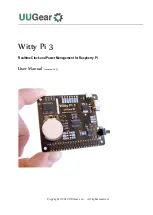
Installation and Programming Manual
Technical terminology and Glossary
83
Violation of a zone with this configuration will not generate an alarm but will trigger the
associated Timer (refer to Exit time).
For example, the zone that monitors the main door of a residence or building is usually
configured as a delayed exit zone, in order to give occupants time to leave the partition after an
arming operation. If the user does not leave the zone within the set “Exit time”, the system will
generate an alarm.
DELAYED EXIT ZONE
This is an explicit user-command which ends signaling on the red keypad/reader LEDs of the
following events:
•
Zone Alarm
•
terminal tamper
•
open panel or dislodged panel
•
peripheral tamper (keypads, expansions, readers)
•
peripheral loss (keypads, expansions, readers)
•
false key
If you delete the alarm/tamper memory, the visual signals on the red reader/keypad LEDs will
clear.
DELETE ALARM/
TAMPER MEMORY
This device allows the control panel to send report calls to Alarm Receiving centres (ARC).
SmartLiving control panels provide a built-in digital dialer which supports all the most widely
used protocols.
DIGITAL DIALER
An electrical input point used for the management/supervision of signals coming from 2
intrusion detection devices.
The terminal the zone is connected to must be configured as a “double input zone". Terminals
with this configuration allow the system to distinguish between two distinct alarms coming from
the two different zones it is connected to.
DOUBLE ZONE
The time (expressed in minutes or seconds) that the system allows the user to disarm the
partition after zone violation. It the system is not disarmed within the set time it will generate
an alarm.
Each partition can be programmed with its own Entry time.
ENTRY TIME
(OR ENTRY DELAY)
A status or operative mode recognized by the system.
For example: detector alarm, mains failure, user-code recognition, etc.
Each event (e.g. mains failure) can be associated with an activation event (when the event
occurs) and a restoral event (when the event ends).
Each event can be programmed to generate the following actions:
•
activation of one or more outputs
•
transmission of one or more e-mails
•
send one or more SMS messages
•
activation of one or more voice calls
•
activation of one or more digital calls
For example, it is possible to activate output 3 when the event starts and to activate output 5
when it restores.
EVENT
This is the non-volatile portion of the memory the panels saves events to. The events are saved
in chronological order with the following details:
•
event description - with details regarding new events and restorals
•
information regarding the user or the cause of event
•
event location
•
event date and time
The events log can be viewed by the system users and the installer.
Partition events (zone alarms, partition alarms, arm/disarm operations, recognized codes and
keys, etc.) can be viewed by users with at least one partition in common with the event
element.
For example, if a user arms several partitions from a keypad, the events log will show:
•
description of the event - “Arm request”
•
description of the code and partitions involved
•
description (label) of the keypad involved
•
date and time of the request
EVENTS LOG
(OR EVENTS
MEMORY)
A short period (expressed in minutes or seconds) during which the user must disarm the
partition after violation (for example, after opening the front door) otherwise the system will
generate an alarm.
Each partition can be programmed with its own Exit time.
EXIT TIME
(OR EXIT DELAY)
These boards can be used to increase the number of terminals (zones or outputs) and/or the
size of the system (in order to extend it over a larger area). Expansion boards can be connected
to the system via the I-BUS.
The Flex5 expansion has:
•
5 fully-programmable terminals
•
a Buzzer (for audible signals)
•
1 analogue output
EXPANSION BOARDS
(FLEX5)
A condition which indicates that a system component is not working properly.
Some faults can jeopardize the performance of the entire system. Mains failure (230V a.c.),
telephone line-down and low battery are typical faults.
FAULT
This type of zone usually comprises a motion detector which senses for the presence of
movement in the protected partition. For example, PIRs, Double technology detectors, magnetic
contacts on doors and windows.
GENERIC ZONE
















































